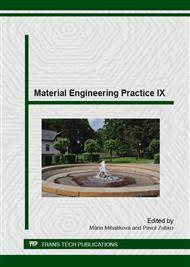p.89
p.94
p.100
p.106
p.112
p.118
p.122
p.127
p.131
Cleanness and Mechanical Properties of Steel after Remelting under Different Slags by ESR
Abstract:
Quality of machine production is very close-knit with quality of metallurgical semi-products and with improvement their working properties. It can be achieved first of all by decrease of sulphur and non-metallic inclusions content in metal. Improvement of working properties provide remelted processes above an electro slag remelting (ESR). The slags play very important role by ESR process. By experiments steel with next chemical composition was used: C (0,9 – 1,1%), Mn (0,30 – 0,50%), Si (0,15 – 0,35%), Cr (1,30 – 1,65%), Ni (max.0,30%), Cu (max.0,25%), P (max.0,027%), S (max.0,030%). The steel was remelted under 8 types of slags on the base of CaO, Al2O3, CaF2 and SiO2 in different ratios. The contribution deals with influence of chemical composition of slag on mechanical properties and cleannes of metal after electro slag remelting. Variation of slag chemical composition enables to change chemical composition of remelted steel, to reduce the non-metallic inclusions and sulphur content and to improve the mechanical properties of steel.
Info:
Periodical:
Pages:
112-117
Citation:
Online since:
December 2014
Authors:
Price:
Сopyright:
© 2015 Trans Tech Publications Ltd. All Rights Reserved
Share:
Citation:


